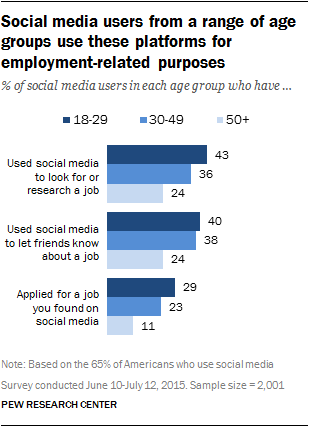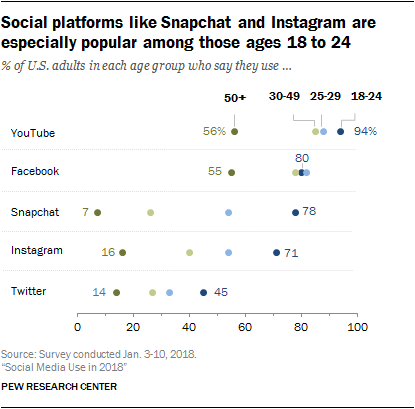Just a decade ago, a job candidate’s “first impression” of a company usually happened during the first five minutes of an interview. Nowadays, LinkedIn — or a myriad of other social media channels — serves as the jobseeker’s initial opportunity to make that solid first impression. Even if a prospective candidate isn’t actively searching for a new job, he or she is likely networking through the use of social media sites like LinkedIn, Twitter, Facebook and others.
It’s safe to say social media has become an integral part of the employee journey, and is often the first touchpoint between candidates and employers.
Social media profiles have also become a critical component to a company’s overall employer branding strategy, as jobseekers often do their homework before deciding whether or not to work for your company. In many cases, social media platforms have become another avenue for jobseekers to discover new open positions at your company and learn about the people who work there. Millennials are especially driving this shift in social recruitment processes — the Pew Research Center in 2015 found that 43% used social media to search for or research a job; 29% applied for a job they found on a social media site.
While social media sites give both job candidates and employers an opportunity to connect and make a strong first impression, it’s often tough to know how much or how little to engage. As a career management practitioner, I’ve worked with recruiters and hiring managers who fall somewhere on the spectrum of having no engagement with candidates via social networks, and engaging across every site.
Social recruitment is an art, not a science. Yet there are some hard and fast rules when it comes to conducting research on job candidates before they’re hired. Strike the balance between policies and best practices to harness the power of social media in recruiting while protecting yourself and your organization from claims of unfairness or prejudice. Here are a few ways to start.
Policies and procedures
All companies should have a social media policy, for both how their brand appears and guidelines for how employees represent the company on their own social media channels. Obviously, the level and depth of the policy varies based on the industry and company. This policy is different than a brand’s social media strategy.
Even more specifically, companies should consider implementing a policy or rules with their recruiting team or HR department in regards to how they leverage social media sites with job applicants and candidates. If nothing else, the policy should state very clearly that if you are going to use social media to research candidates before they’re hired, that investigation needs to be directly related to the job they are going to perform. For example, it’s appropriate to look at the Facebook and Twitter profiles of the social media director you’re looking to hire, but probably unnecessary for an electrical engineer. LinkedIn is an exception to this rule, as both employees and employers typically see this network as an online resume and professional resource.
In some ways, setting policies or rules brings us back to the basics of recruiting. Your recruiting process should have a structured approach, and your team should know which skillsets and experiences are non-negotiable for incoming candidates. Social media — for better or for worse — sometimes provides us unnecessary information that can even get in the way of bringing in a perfectly qualified candidate.
At the end of the day, recruiters can’t un-see what they’ve already seen. While it might seem an unlikely outcome, candidates who don’t get a job with your company may come back to accuse you of not hiring them due to discrimination based on information found in their social media profiles. When your team is adhering to policies, it gives you a defensible position and more importantly, it keeps the process consistent and unbiased for every candidate.
Hiring for fit or like-mindedness
Recruiters, anecdotally, are prone to leveraging social media networks to screen for cultural fit. The problem arises when we start to see culture fit as hiring people who are just like us, share our ideas and ideals and align with us socially and politically. In these cases, recruiters and hiring managers need to be reminded that culture fit does not mean like-mindedness.
In fact, companies who build diverse teams, including diversity of opinion, tend to be more resilient, innovative, and ultimately successful. High-growth organizations rely on people to think differently and challenge the status quo. To avoid groupthink and solve problems for an increasingly diverse customer base, employing people from all walks of life has become mission critical.
That’s not to say that hiring for cultural fit isn’t important in some capacity. You just need to make sure that you’re hiring folks who believe in your company’s values and mission. These attributes are incredibly difficult to measure by assessing candidates using their social media networks. For all you know, that person only chooses to leverage his or her social networks for discussions with friends, and scrolling through pictures and discussions simply wouldn’t be a fair assessment of whether or not the candidate believes in your values and mission.
There are, however, some strategic actions HR teams can take to ensure job candidates will thrive within the confines of your company culture. Use your company social media networks to expose candidates to what it would be like to work at your company. Invite the candidate to a game night or a lunch to interact with employees. See them in action, as opposed to checking out their online social media history.
The art of social media
The actual usage of particular social media sites, from Snapchat to WhatsApp to Pinterest, varies greatly by demographic and generation, according to Pew Research. The researchers found that 73% of the American public uses more than one of the eight platforms measured in the survey, and the typical American uses three. The takeaway from this data is that social media usage varies so widely that it’d be unfair to assume that all your job candidates are leveraging the same social media networks in the same way at the same time. And by making social media screenings a part of your recruiting process, you might be adding unnecessary bias based on information they’ve elected to make public, or vice versa.
If looking at LinkedIn profiles is instrumental to your recruiting process, there’s a strong chance you’re losing access to many quality candidates who have simply made decision to not create a LinkedIn profile. And in some industries, such as retail or construction, LinkedIn is not the norm. In those cases, it isn’t in your best interest to seek out your candidates there.
As a general rule of thumb, we must stop making assumptions about candidates based on their social media choices. While social media may be viewed as a way to speed up the process for finding information or fact-checking candidates, it’s not always the best approach. It usually works best as part of a consistent, unbiased recruiting strategy where social media isn’t the only opportunity a candidate has to make a solid impression with your company.
